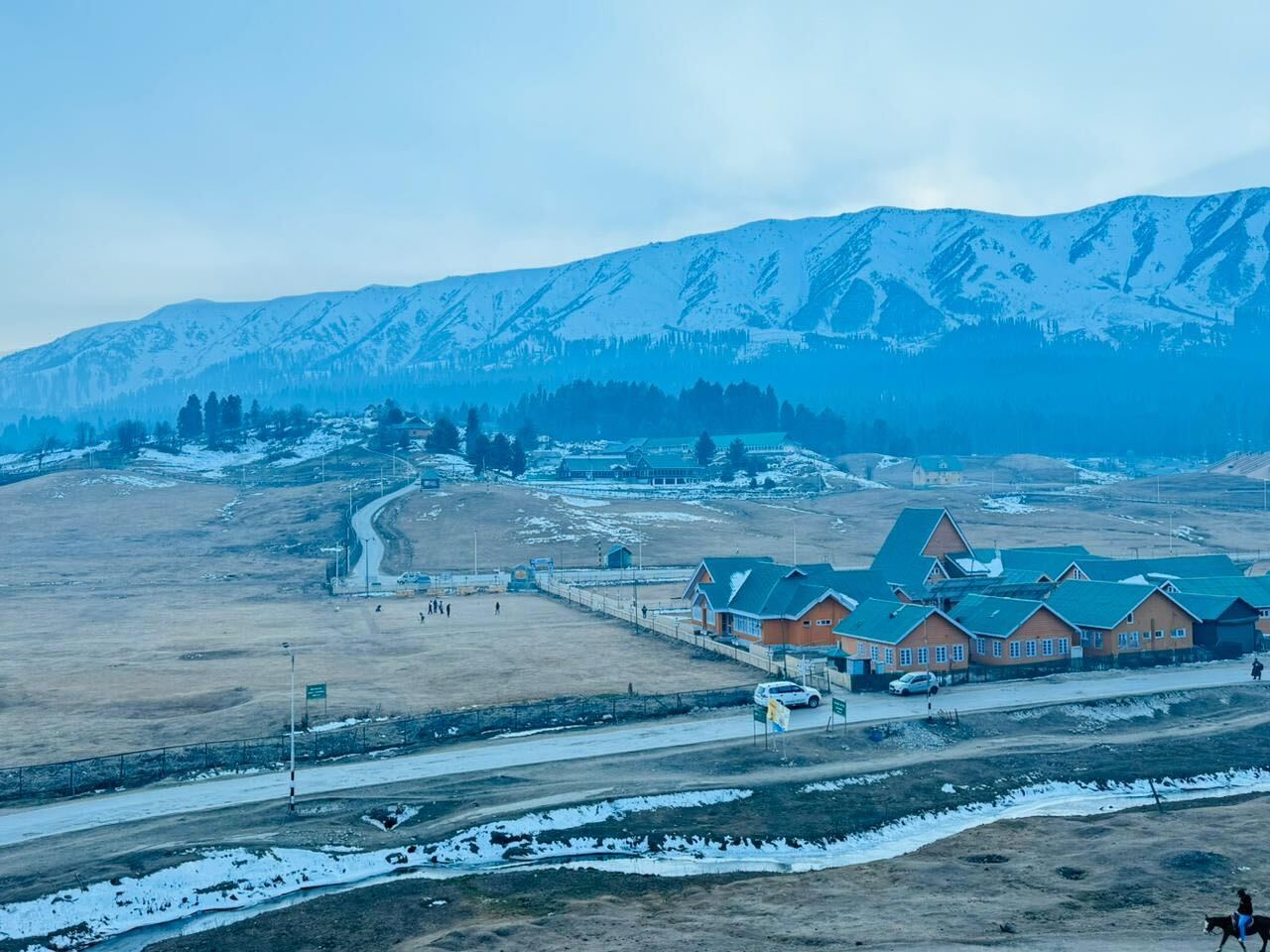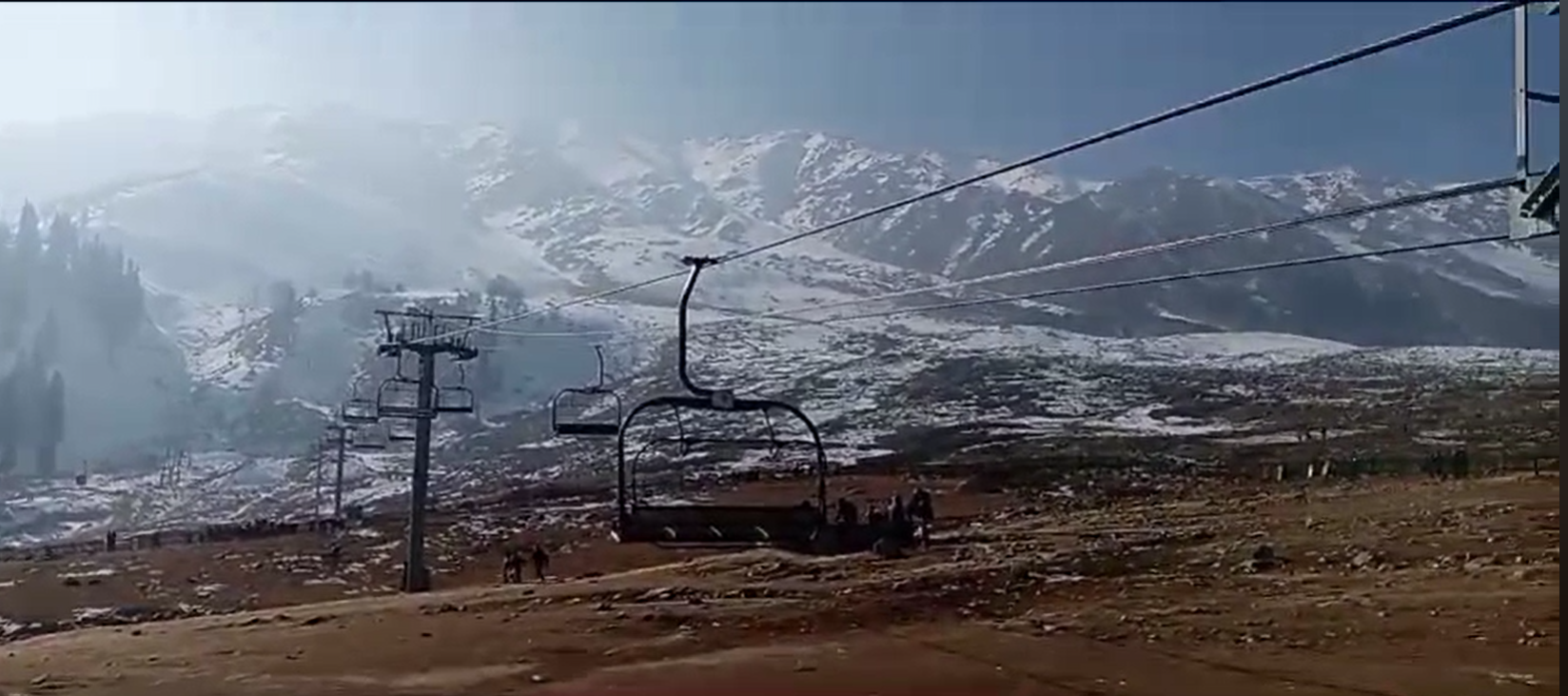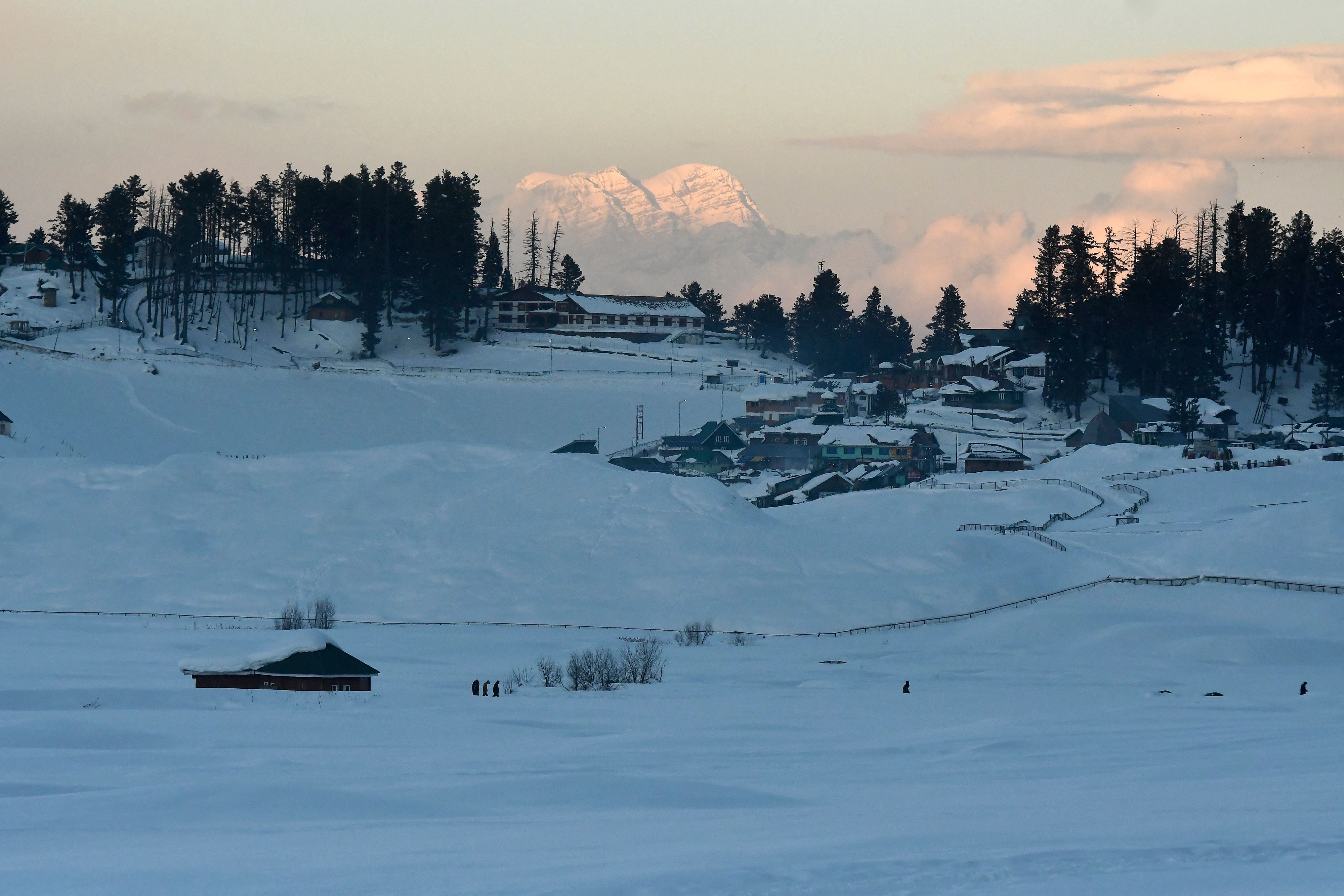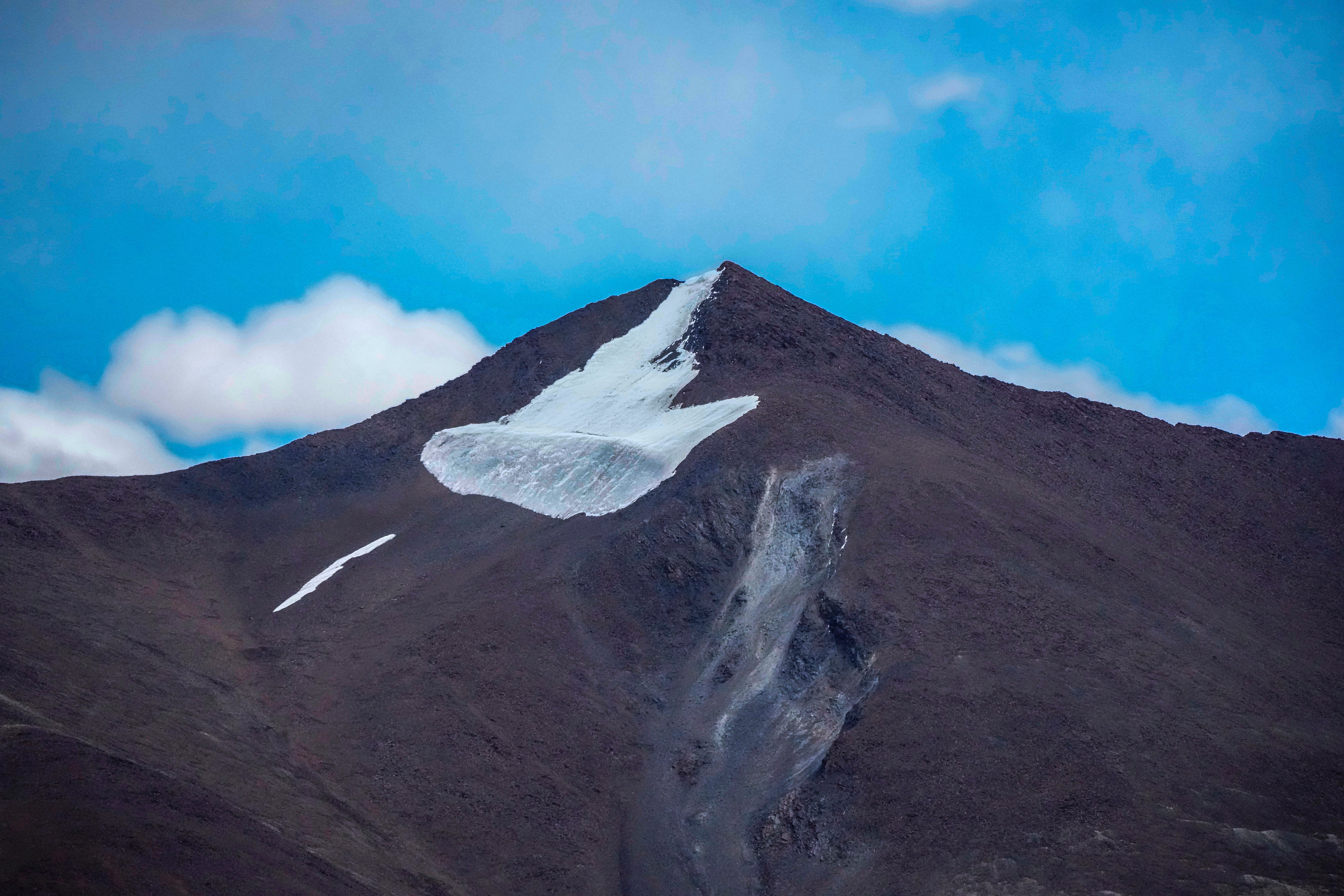India’s top Kashmir ski resort fears for future after lowest snowfall in seven years
Kashmiri business owners ‘heartbroken’ as prolonged dry spell causes extensive losses during peak winter tourist season. Shweta Sharma and Stuti Mishra report


Gulmarg, the world’s third-highest ski resort, usually looks like a town out of a winter postcard at this time of year, with its snow-covered houses, frosty blue pine trees and slopes bustling with snowboarders and skiers.
The beautiful pastoral town in Kashmir at an elevation of 3,950 metres is aptly named the “meadow of flowers” and thrives on tourist business, especially during the winter months due to the heavy snowfall it receives. Businesses here employ thousands of locals who rely on snow activities such as skiing, snowmobile rides, and sledging during the season.
But not this year.
Resort owners in India’s Kashmir have been left in the lurch after the driest winter spell in recent years has left the valley almost entirely without snow cover, raising concerns over the intensifying impact of the climate crisis in this vulnerable region.
Showkat Ahmed, president of the skiing association in Gulmarg, tells The Independent the locals are “heartbroken” with this year’s prolonged dry spell leaving them to “only count losses”.
Calling it a “grim period”, Ahmad says “98 per cent of our work has been lost” as back-to-back bookings were cancelled by international and domestic visitors.
“The snowfall, delayed this year, is a stark deviation from the norm, impacting the entire Kashmir region,” he says.
Farhat Naik, a professional snowboarder and instructor who hosts dozens of international tourists each year, has been getting similar cancellation emails and calls as tourists from Europe and the US stay away after seeing the weather forecast.
“The prolonged dry spell of winters is wreaking havoc on the livelihoods of many, including me,” Naik tells The Independent.
“I recently received an email from one of my groups, which had confirmed a 15-day skiing package with me, to cancel the booking,” Naik says.

Typically, Kashmir sees its first snowfall in December and by January, the grounds are entirely covered in thick layers of pristine white. But this year only light showers have been recorded in the lower grounds while temperatures remain much higher than average.
There is no immediate respite in sight as the Indian Meteorological Department says Gulmarg will not receive any fresh snowfall and the sky will remain clear until at least 15 January.
“There is no major relief from this dry spell for the next few days,” Mushtaq Ahmad, director at the Srinagar bureau of India’s weather department, tells The Independent.
Ahmad says preliminary data shows this is the driest winter the region has experienced since 2016.

Temperatures in the region have been much higher than average. On Tuesday, Srinagar recorded a maximum temperature of 14.2C, marking an 8.1C increase from the usual temperature for this time of the year.
The valley also reported a 79 per cent rainfall deficit throughout December.

Mahesh Palawat, a meteorologist based in Delhi, says such mild winters in Kashmir are “very rare” but hardly surprising after the record-breaking temperatures seen worldwide.
Last year has been confirmed as the hottest on record by scientists. The northern hemisphere recorded some of the worst heat-related disasters this year, with wildfires burning millions of hectares of land and heatwaves raising emergency alerts from Japan to China, India, Europe and the United States.
It’s not just Kashmir; other Himalayan regions in India, like Himachal Pradesh and Uttarakhand, are also witnessing lower snowfall.
Palawat explains the reason behind this delay is no western disturbance, a feature of Indian monsoons that brings rainfall and snow.
“In January we generally see two to three active western disturbances usually approaching the western Himalayas, but this year we have not seen any,” says Palawat.
“We can say this is one of the driest winters in the area. Due to climate change, all the weather patterns in the region are erratic.”
High temperatures coupled with low precipitation are having disastrous effects on the ecosystem in a region which has already been suffering from the stress of ongoing conflicts and protests.
Tourism has remained one of the fastest-growing economic sectors in the region, accounting for almost 8 per cent of the Himalayan union territories’ gross domestic product.
In 2022, after Kashmir opened up after two back-to-back pandemic lockdowns and another triggered by political turmoil, the Indian region received a record-breaking 18 million tourists, according to government data.
Naik emphasises that the delicate balance with nature is breaking due to the influx of tourists each year and the excessive use of snowmobiles and other vehicles in ecologically sensitive areas.
“We are overburdening this place with so many people, so many cars, and we are using the snowmobile at an altitude where you will not see anywhere in a world ski resort,” Naik points out.
He fears that the daily influx of thousands of cars, taxis and other private vehicles could accelerate the phenomenon Kashmir is witnessing right now.

The snowmobiles that offer thrilling rides to tourists in snow-packed terrains have only been in operation for three days and have remained out of work for the most part until now, Manzoor Ahmed Lone, president of Snowmobile Association Kashmir in Gulmarg, tells The Independent.”
“With only around 10cm of snow this season, a fraction of the usual, we need at least 60cm to operate our snowmobiles,” Lone, who runs 50 such snowmobiles in Gulmarg, says.
“For the first time in four decades, horses are navigating to phase one of Apharwat Peak, where snowmobiles used to be the preferred mode of transport.”
The sudden environmental shift and its impact on the livelihoods of the people has now many fearing whether such frequent disturbances would permanently alter the fate of Kashmir’s snow-dependent tourism industry.
Climate experts are also worried about the impact less snow is going to have on the region’s crucial 18,000 glaciers which form the region’s lifeline and are already melting at an accelerating rate.
A recent report by international scientists warns that glaciers in the Hindu Kush region of the Himalayan mountains could lose up to 80 per cent of their ice by the end of the century at the current rate of heating.
“If this trend continues for another decade or so, then the glacier will deplete at a faster pace because the fresh form will not be there,” says Palawat.
Join our commenting forum
Join thought-provoking conversations, follow other Independent readers and see their replies
Comments
Bookmark popover
Removed from bookmarks